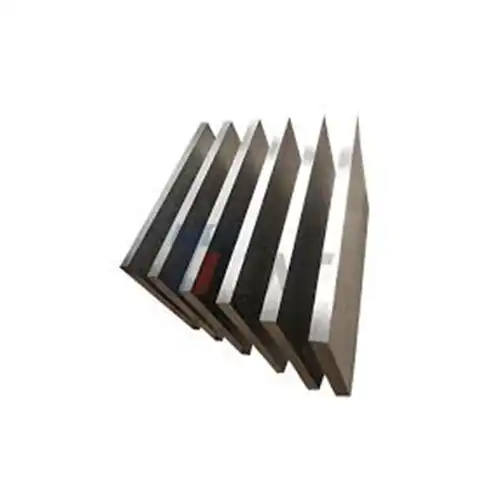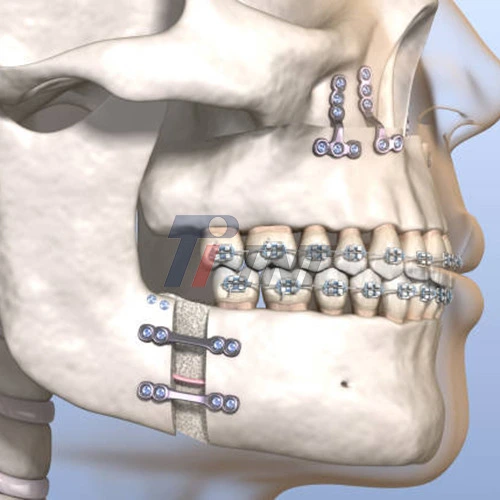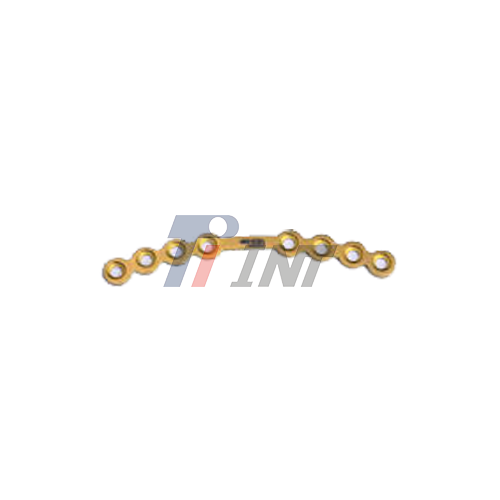The Evolution of Mandibular Fracture Treatment
Historically, mandibular fractures were treated using wire fixation techniques, which often required patients' jaws to be wired shut for extended periods. This approach, while effective, came with significant drawbacks, including patient discomfort, difficulty in eating and speaking, and potential complications such as malnutrition and muscle atrophy. The introduction of titanium plate fixation has transformed the landscape of mandibular fracture treatment, offering a more efficient and patient-friendly alternative.
Titanium plate for mandibular fracture repair have gained widespread acceptance in the medical community due to their exceptional properties. These plates are designed to provide stable fixation of fractured bone segments, promoting optimal healing while allowing for early mobilization of the jaw. The use of titanium in medical implants dates back to the mid-20th century, with its biocompatibility and durability making it an ideal material for orthopedic and maxillofacial applications.
The process of titanium plate fixation involves surgically placing small plates across the fracture site and securing them with screws. This technique enables precise alignment of the fractured bone segments, facilitating proper healing and restoration of normal jaw function. Unlike traditional wire fixation methods, titanium plate fixation often allows patients to resume normal jaw movement and eating habits much sooner after surgery.
Advantages of Titanium Plate Fixation for Mandibular Fractures
The use of titanium plates in mandibular fracture surgery offers numerous benefits over conventional treatment methods. These advantages contribute to improved patient outcomes, faster recovery times, and enhanced quality of life during the healing process.
Biocompatibility: Titanium is renowned for its exceptional biocompatibility, meaning it is well-tolerated by the human body. This property minimizes the risk of adverse reactions or rejection of the implant, making titanium plates a safe and reliable option for mandibular fracture fixation. The body's acceptance of titanium allows for long-term stability of the implant, reducing the need for subsequent surgeries or implant removal.
Strength and Durability: Titanium plates offer high strength-to-weight ratio, providing stable support for bone fractures without excess bulk, and remain durable, often eliminating the need for removal surgery.
Corrosion Resistance: Unlike some other metals used in medical implants, titanium demonstrates excellent resistance to corrosion when exposed to bodily fluids. This property contributes to the long-term stability of the implant and reduces the risk of metal ion release into surrounding tissues, further enhancing the safety profile of titanium plate fixation.
Enhanced Stability:Titanium plates offer superior stability over wire fixation, promoting faster, predictable healing, reducing malunion risk, and enabling early jaw mobilization for quicker recovery in speaking and eating.
Improved Aesthetic Outcomes: The use of titanium plate for mandibular fracture repair often results in better aesthetic outcomes compared to traditional wire fixation methods. The plates are designed to be low-profile, minimizing visible contour irregularities beneath the skin. Additionally, the precise alignment facilitated by titanium plate fixation helps maintain the natural contours of the face, contributing to improved cosmetic results.
Reduced Hospitalization Time: Titanium plate fixation shortens hospital stays, reduces jaw immobilization, and allows earlier return to normal activities, improving patient satisfaction and lowering healthcare costs.
Versatility in Fracture Management: Titanium plates are available in various sizes and configurations, allowing surgeons to tailor the fixation method to the specific needs of each patient and fracture pattern. This versatility enables optimal management of complex mandibular fractures, including comminuted fractures or those involving multiple segments.
Surgical Considerations and Techniques
The successful implementation of titanium plate fixation for mandibular fractures requires meticulous surgical planning and execution. Surgeons must consider several factors to ensure optimal outcomes and minimize potential complications.
Preoperative Assessment: A thorough preoperative evaluation is crucial for determining the most appropriate fixation strategy. This assessment typically involves detailed imaging studies, such as computed tomography (CT) scans, to evaluate the fracture pattern and plan the placement of titanium plates and screws. The surgeon must also consider factors such as the patient's age, overall health status, and functional requirements when selecting the appropriate fixation technique.
Plate Selection and Positioning: The choice of titanium plate type and size depends on the location and nature of the fracture. Miniplate systems are commonly used for mandibular fractures, offering sufficient strength while maintaining a low profile. The positioning of the plates is critical for achieving optimal fracture reduction and stability. Surgeons must carefully consider biomechanical principles to ensure that the plates effectively neutralize forces acting on the fracture site during normal jaw function.
Surgical Approach: The surgical approach for titanium plate fixation may vary depending on the fracture location and complexity. Intraoral approaches are often preferred when possible, as they eliminate visible scarring. However, some fractures may require external approaches to achieve adequate exposure and plate placement. Minimally invasive techniques, such as endoscopic-assisted plate fixation, are increasingly being employed to minimize surgical trauma and improve postoperative recovery.
Bone Reduction and Fixation: Accurate reduction of the fractured bone segments is paramount to successful titanium plate fixation. Surgeons must ensure proper alignment of the occlusal surfaces and restoration of the mandibular arch form. Once reduction is achieved, the titanium plate for mandibular fracture are contoured to match the surface anatomy of the mandible and secured with screws. The use of specialized instruments and techniques, such as drill guides and depth gauges, helps ensure precise placement of screws and minimize the risk of injury to adjacent structures.
Postoperative Care and Rehabilitation: While titanium plate fixation allows for earlier mobilization of the jaw compared to wire fixation, proper postoperative care remains essential for optimal healing. Patients are typically advised to follow a soft diet for several weeks and may be prescribed antibiotics to prevent infection. Physical therapy and jaw exercises are often recommended to restore full range of motion and prevent muscle atrophy. Regular follow-up appointments allow the surgeon to monitor the healing process and address any concerns that may arise.
Potential Complications and Management: Although titanium plate fixation is generally safe and effective, potential complications can occur. These may include infection, hardware loosening, or exposure of the plates through the soft tissues. Early recognition and appropriate management of complications are crucial for ensuring favorable outcomes. In rare cases where complications persist or the plates cause discomfort, removal may be necessary. However, the biocompatibility and long-term stability of titanium plates often allow them to remain in place indefinitely without issue.
Conclusion
The success of titanium plate for mandibular fracture surgery underscores the importance of ongoing research and development in medical materials and techniques. As technology advances, we can anticipate further refinements in plate design, fixation methods, and surgical approaches, potentially leading to even better outcomes for patients suffering from mandibular fractures.
For those seeking high-quality titanium materials for medical applications, including mandibular fracture repair, Baoji INT Medical Titanium Co., Ltd. offers a comprehensive range of titanium products. With over 30 years of experience in the research, development, and production of titanium materials, INT has established itself as a leader in the medical titanium industry. Their products, including titanium plates, rods, and wires, are manufactured to the highest standards, ensuring reliability and performance in critical medical applications. For more information about INT's medical titanium products, please contact them at export@tiint.com.











 2025-10-10 08:47:36
2025-10-10 08:47:36

